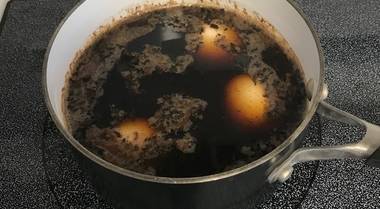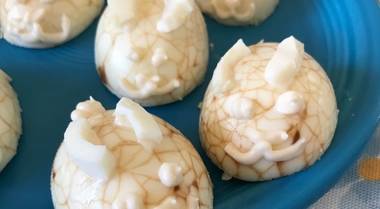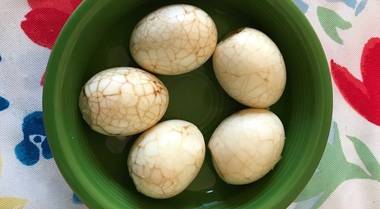Recipe: Marbled Easter Egg Rabbits
by Abby Morrison
April 08, 2020

Today, we wanted to walk you through how to make them, including a few variations in time for egg-dying season, as well as tips on how you can make these adorable eggs even more precious as bunny-shaped sides for your Easter meal.
There are a ton of recipes for Chinese tea eggs out there, including two on our very own TeaChef (here and here). A quick google search will find you a variety of recipes, each with their own special mix of spices, though most feature soy sauce, sugar, star anise, and cinnamon, with things like Chinese five-spice powder (or its components), bay leaves, salt, and more giving each recipe its own special twist. They can be made soft- or hard-boiled, and can even be turned into deviled eggs.

1 - Hard boil the eggs. Transfer them to an ice bath after boiling to stop the cooking process.
2 - Crack each egg's surface with the back of a spoon, enough to allow the tea to seep through the cracks, but not so much that the shell falls off or that the egg is damaged.
3 - Bring the tea and spice mixture to a boil in a combination of water and soy sauce.
4 - Add the eggs and simmer.
5 - Chill the eggs in the tea and spice marinade long enough for the marbling to take, typically overnight, though timing varies.
6 - Peel the eggs and enjoy!
For mine, I made them two ways, one following a recipe from the book Culinary Tea by Cynthia Gold and Lisa Stern that used lapsang souchong, and one using matcha instead of the spices and other liquids. I was hoping to get a nice Spring-y green with the latter, but they actually turned out a darker brown, though that could just be from my increased proficiency in egg cracking as time went on. Other teas that could still be tested for staying power could be Earl Grey Bella Luna, Bella Luna Blue, or a white tea with some food coloring or natural dyes as discussed below.

Marbled Tea Egg Rabbits

To make these little friends for your table, start by cutting a tea egg in half, length-wise. Use a really sharp knife, without serration, and if you have any membrane problems as I did, use slow, small sawing motions to keep the membrane from peeling off. Set one half aside to use as the tea rabbit's body. The other half can be used to make several sets of ears (I made five eggs total, and found that one egg half was enough to make the ears for all of the other halves).
To make the ears, cut the other egg half into strips, width-wise. In areas where the white is thicker, consider cutting each slice into smaller, nesting slices to get more ears out of each piece.
Once you're ready to assemble, put some mayonnaise into a small plastic bag, cutting off the tip. Pipe a little onto the tea rabbit's back to hold the ears in place and then add the face and tail.
Bonus tip: If you want to get creative, you can use other things for the facial features. For example, use olives or pickles to create the eyes and nose or use deviled egg filling to make a tail or a flower garland to rest your ears on. Culinary Tea offers recipes for both oolong and matcha mayo, which could be used for this purpose too, as well as Toasted Pepper Salt and Tea-Smoked Salt for garnishes. You can even use leftover garnishes to make a little garden for your rabbits to explore. The sky is the limit!
Tea-Dyed Eggs

The simple solution? Use tea to dye eggs without the cracks.
There are several ways to do this, but one that I liked, in particular, was on the site Thirsty for Tea. By using a variety of different teas and a few natural ingredients such as beet juice to enhance color, writer Bonnie Eng was able to create some really beautiful eggs with a variety of colors. Since you have to steep the eggs overnight, it does take a little longer to make them than egg dying kits you might find in a store, but the overall effect is so bright and beautiful, it's worth the wait.
So there you have it, three different ways to enjoy tea-dyed eggs, as traditional marbled tea eggs, as tea egg rabbits, or simply dyed with tea. Either way, you're going to have a beautiful addition to your Easter activities and a tasty recipe for any occasion.
Finally...
Once your tea eggs are done, don't forget to share them with us on social @adagioteas! We'd love to see all the eggs, colors, and creatures you come up with, and of course, if you come up with a new recipe of your own, make sure to share it on TeaChef!